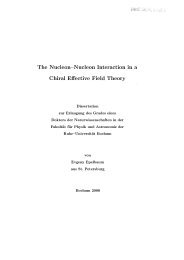t Hooft mechanism of confinement or dual Meissner effect
t Hooft mechanism of confinement or dual Meissner effect
t Hooft mechanism of confinement or dual Meissner effect
You also want an ePaper? Increase the reach of your titles
YUMPU automatically turns print PDFs into web optimized ePapers that Google loves.
Best dreams fulfilled! [A. Polyakov, Nucl. Phys. B (1977)]. However,<br />
i) d = 2 + 1 and ii) the gauge group SU(2) is explicitly broken by the Higgs field down<br />
to U(1) where the <strong>dual</strong> photon gets the mass.<br />
M<strong>or</strong>e recent achievements:<br />
• N = 2, d = 3 + 1 supersymmetric the<strong>or</strong>y, s<strong>of</strong>tly broken to N = 1 supersymmetric<br />
the<strong>or</strong>y. It is also shown to possess <strong>confinement</strong> and mass gap – m<strong>or</strong>e <strong>or</strong> less due to<br />
the same <strong>mechanism</strong> (<strong>of</strong> monopole condensation) [Seiberg and Witten (1994), Douglas<br />
and Shenker (1995)]<br />
• pure Yang–Mills d = 3 + 1 non-supersymmetric the<strong>or</strong>y [D.D. and Petrov (2007)] is<br />
also shown to possess <strong>confinement</strong>, at least at the semiclassical level!<br />
Confinement in the 3d Ge<strong>or</strong>gi–Glashow model D. Diakonov, L-12












